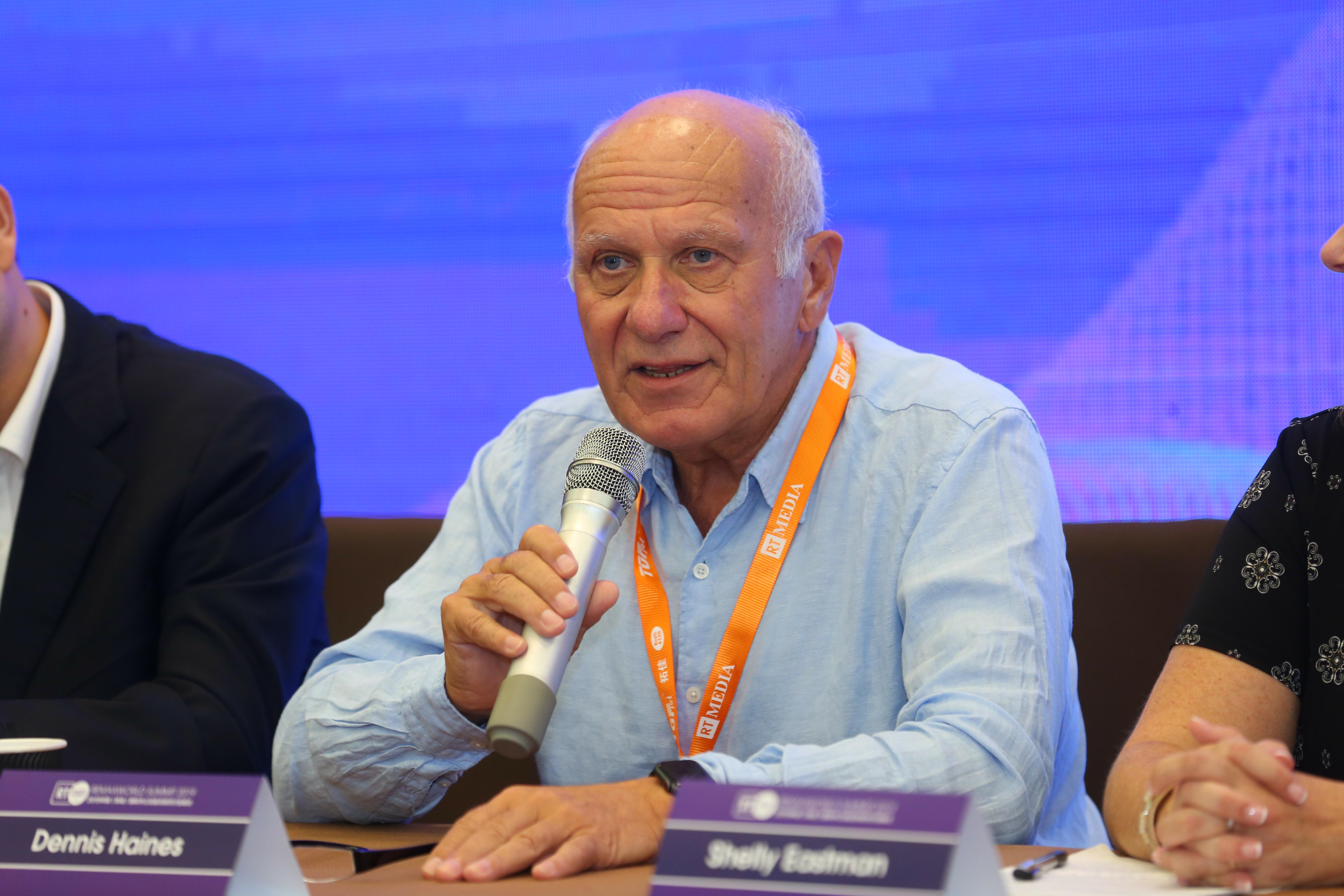Fear, Uncertainty and Doubt
Fear, Uncertainty and Doubt, Badger’s CEO Dennis Haines speaks frankly about bullying and taxes

Dennis Haines in RemaxWorld Summit
Prior to getting involved in aftermarket printer supplies, Dennis Haines had a senior VP role in a large international computer hardware OEM. While not involved with OEM printer supplies, this background gave Haines a unique insight into how the OEMs operate when dealing with competition from so called “aftermarket” operators. He is very well aware of what he describes as a FUD strategy and has seen how effective it can be. FUD is a deliberate attempt by OEMs to create Fear, Uncertainty and Doubt. FUD can have many elements to it, including but not limited to real and implied issues relating to IP, warranty and service.
His experiences in the printer supplies market began with inkjet cartridges around 15 years ago at a time when e-commerce was in its infancy. In those days, there were too many concerns from consumers about entering credit card details online to execute purchases. This is in sharp contrast to the situation today. While he has business interests in Spain, France, Australia and New Zealand, his primary operations are in the UK, where the uptake of e-commerce is unparalleled.
According to Haines and the recent data he holds, the UK leads the way globally in terms of the percentage of total retail spend that takes place online. This is consistent with statistics published by www.salescycle.com: “Online retail had a 14.3 percent share of total retail sales in 2018, up from 12.9 percent in 2017 and 11.6 percent in 2016. In this respect, the US is the third most advanced ecommerce market worldwide, with the UK and Germany in first and second place.”1
Remans vs New Builds
One of the key battles being fought in the aftermarket currently is the whole “Remanufactured versus New Build Cartridge (NBC)” argument. On the one hand, NBCs have a significant cost advantage over the Remanufactured. This is often perceived as unfair. Remanufacturers must support the significant costs of infrastructure to bring back used products from the market since without this “raw material” they cannot exist. NBC players do not have these costs to contend with. On the other hand, there is a growing awareness and understanding of the negative consequences of single use plastic. Should this not be driving demand for remanufactured cartridges?
Haines’ view of the market is refreshingly simple, even if it does not make pleasant listening for remanufacturers. There are 3 market segments. These comprise, large corporate enterprises, SMEs and consumers. In his experience, the interest of each segment in NBC versus Remanufactured can be summarised as follows:
- Consumer: Zero interest
- SME: Low interest
- Large Enterprise: Higher level of interest
Haines points out that large enterprises have more pressure to be, or at least to be seen, as good corporate citizens and are keen to enhance the CSR page of their annual reports. The Haines view would seem to indicate an urgent need for educating the consumer and SME segments to the green advantages of remanufacturing.
OEM Strategies
The battle between NBCs and Remanufactured, however, is only one of several important issues that impact the marketplace today, according to Haines. Another is the FUD strategies being used by the OEMs and referred to earlier. This impacts both NBC and Remanufacturing players. Perhaps there was a time when, due to the right-to-repair doctrine, Remanufactured products were perceived as less risky compared with NBC products. While we continue to see multiple take downs of new build cartridges on platforms such as Amazon, as Canon continue to target NBC HP compatible toner cartridges that they believe infringe, we have also seen multiple attacks by the OEM on Remanufacturers going back to the twisted prism gear patents and more recently the detached dongle.
Furthermore, and Haines has direct experience with this, HP has been using the first-sale doctrine as a tactic to knock our competition in the inkjet arena. Many of his reseller customers had received cease and desist orders which came back to him. These allege that certain cartridges had been remanufactured and sold in one region but the empty cartridges had originated in another region. On the other hand, the manufacturer and/or the supplier of the empty cartridges claim that the cores have been sourced from the correct region. In such cases, he has asked HP to provide details that allow him to identify one region from another in order that he can be compliant. However, no such information has been forthcoming. He also has documents relating to challenges on items that have never actually been sold through into the market. Clearly, there is a strong feeling that certain OEMs are using scare tactics and unfair practices to create Fear, Uncertainty and Doubt (FUD).
A third major challenge facing importers, trade distributors and even resellers is Amazonification of the channel. Again, Haines’ analysis is refreshingly simple. In the UK, whilst the percentage of retail spending in total may only be 18%, he believes it is very much higher where printer cartridges are concerned. In SME and consumer segments, online is the major procurement route and there are three major channels which likely apply to many markets, not just in the UK:
- Amazon
- e-Bay
- 1,000s of independents
The independents, of course, have SEO type challenges to mitigate against Amazon and e-Bay. However, another challenge of which Haines has personal experience is the disruption of the traditional supply chain, enabled by the advance of technology and the internet.
The traditional “manufacturer to importer/distributor to reseller to user” model no longer has the value it once did. Large successful online retailers are able to source direct from manufacturers. Haines has experience of his own vendors bypassing him to reach his largest trade buyers.
Tax Abuses
Additionally, Haines highlights something more disturbing which relates to improper value-added tax (VAT) practices. He believes there is a significant volume of product being sold in the UK over the internet that is delivered to end-users from warehouses in the UK and on which VAT is not being charged or reported. This results in an unfair price advantage. If, and when customers ask for a VAT invoice, they are met with one of two responses. The first being that the selling company is not VAT registered. The second being that a new invoice will be issued with an additional 20% included. Often the VAT number is not genuine, and the selling company pockets the additional 20%.
Haines has been working with Retailers Against VAT Avoidance Schemes (RAVAS) on this subject. In the UK alone, the value of uncollected VAT is reported to run to more than £2 billion per year and a chunk of this is related to toner and ink cartridges coming into the UK from China. He has been personally involved in supporting RAVAS to collect information, which was forwarded to George Osborne, Chancellor of the Exchequer in the UK until 2016. Frustratingly, the government took an initial position that they make the rules and it would be up to Amazon, e-Bay and so on to implement them and it was not their job to police the situation. This seems to be changing now with more scrutiny from HMRC towards the likes of Amazon. However, there has been, as yet, no noticeable decline in the amount of products being sold through without VAT. The issue is not confined to the UK, and RAVAS has had meetings with OLAF (The European Anti-Fraud Office) in Brussels.2
He estimates that in the whole EU this practice accounts for tens of billions of €uros in uncollected VAT and results in unfair and illegal competitive advantage for unscrupulous operators.
When considering the broad market landscape, Haines believes that there is still room for him and his business, but of course it requires a different business model. While the market is mature and the volume of printing is reducing in Western geographies, the market is still massive and there is an opportunity to succeed and grow, but it will require consolidation, a more direct approach and perhaps different channels.
Footnotes






Leave a Comment
Want to join the discussion?Feel free to contribute!